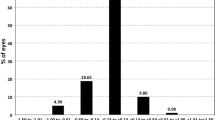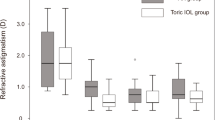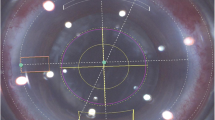Abstract
Purpose
To evaluate the efficacy of astigmatic correction with two types of toric intraocular lenses (IOLs) after femtosecond laser-assisted cataract surgery (FLACS) in eyes with low-to-moderate corneal astigmatism using intraoperative aberrometry for optimizing the position of the toric IOL.
Methods
Retrospective study includes a total of 99 eyes of 73 patients with anterior keratomeric astigmatism ≤ 3 D and undergoing FLACS (Catalys, Johnson & Johnson Vision) with implantation of a monofocal (Ankoris, PhysIOL) or a multifocal toric IOL with the same platform (Pod FT, PhysIOL). In all cases, intraoperative aberrometry was used (Optiwave refractive analysis, ORA, system, Alcon). Visual and refractive outcomes were evaluated preoperatively and at 4 months after surgery with vector analysis of astigmatic changes.
Results
A total of 89.9%, 93.9% and 97.0% showed a postoperative sphere, cylinder and spherical equivalent within ± 0.50 D, respectively. Mean difference vector (DV) was 0.22 ± 0.27 D, mean magnitude of error (ME) was 0.13 ± 0.29 D, and mean angle of error (AE) was 1.52 ± 11.64°. Poor correlations of preoperative corneal astigmatism with DV (r = − 0.032, p = 0.833), ME (r = − 0.344, p = 0.001) and AE (r = − 0.094, p = 0.377) were found. Likewise, no statistically significant differences were found between monofocal and multifocal toric IOL subgroups in DV (p = 0.580), ME (p = 0.702) and AE (p = 0.499).
Conclusions
The combination of FLACS and intraoperative aberrometry to optimize the position of a toric IOL allows a very efficacious correction of preexisting low-to-moderate corneal astigmatism.


Similar content being viewed by others
References
Ferrer-Blasco T, Montés-Micó R, Peixoto-de-Matos SC et al (2009) Prevalence of corneal astigmatism before cataract surgery. J Cataract Refract Surg 35:70–75
Hoffmann PC, Hütz WW (2010) Analysis of biometry and prevalence data for corneal astigmatism in 23 239 eyes. J Cataract Refract Surg 36:1479–1485
Guo H, Atchison DA (2010) Subjective blur limits for cylinder. Optom Vis Sci 87:E549–E559
Miller AD, Kris MJ, Griffiths AC (1997) Effect of small focal errors on vision. Optom Vis Sci 74:521–526
Hayashi K, Manabe S, Yoshida M et al (2010) Effect of astigmatism on visual acuity in eyes with a diffractive multifocal intraocular lens. J Cataract Refract Surg 36:1323–1329
Leon P, Pastore MR, Zanei A et al (2015) Correction of low corneal astigmatism in cataract surgery. Int J Ophthalmol 8:719–724
Gangwani V, Hirnschall N, Findl O et al (2014) Multifocal toric intraocular lenses versus multifocal intraocular lenses combined with peripheral corneal relaxing incisions to correct moderate astigmatism. J Cataract Refract Surg 40:1625–1632
Nanavaty MA, Bedi KK, Ali S et al (2017) Toric intraocular lenses versus peripheral corneal relaxing incisions for astigmatism between 0.75 and 2.5 diopters during cataract surgery. Am J Ophthalmol 180:165–177
Kessel L, Andresen J, Tendal B et al (2016) Toric intraocular lenses in the correction of astigmatism during cataract surgery. Ophthalmology 123:275–286
Emesz M, Dexl AK, Krall EM et al (2015) Randomized controlled clinical trial to evaluate different intraocular lenses for the surgical compensation of low to moderate-to-high regular corneal astigmatism during cataract surgery. J Cataract Refract Surg 41:2683–2694
Hirnschall N, Hoffmann PC, Draschl P et al (2014) Evaluation of factors influencing the remaining astigmatism after toric intraocular lens implantation. J Refract Surg 30:394–400
Hirnschall N, Gangwani V, Crnej A et al (2014) Correction of moderate corneal astigmatism during cataract surgery: toric intraocular lens versus peripheral corneal relaxing incisions. J Cataract Refract Surg 40:354–361
Ho J-D, Tsai C-Y, Liou S-W (2009) Accuracy of corneal astigmatism estimation by neglecting the posterior corneal surface measurement. Am J Ophthalmol 147:788–795
Goggin M, Zamora-Alejo K, Esterman A et al (2015) Adjustment of anterior corneal astigmatism values to incorporate the likely effect of posterior corneal curvature for toric intraocular lens calculation. J Refract Surg 31:98–102
Felipe A, Artigas JM, Díez-Ajenjo A et al (2011) Residual astigmatism produced by toric intraocular lens rotation. J Cataract Refract Surg 37:1895–1901
Savini G, Næser K, Schiano-Lomoriello D et al (2017) Optimized keratometry and total corneal astigmatism for toric intraocular lens calculation. J Cataract Refract Surg 43:1140–1148
de Sanctis U, Donna P, Penna RR et al (2017) Corneal astigmatism measurement by ray tracing versus anterior surface-based keratometry in candidates for toric intraocular lens implantation. Am J Ophthalmol 177:1–8
Koch DD, Jenkins RB, Weikert MP et al (2013) Correcting astigmatism with toric intraocular lenses: effect of posterior corneal astigmatism. J Cataract Refract Surg 39:1803–1809
Preussner PR, Hoffmann P, Wahl J (2015) Impact of posterior corneal surface on toric intraocular lens (IOL) calculation. Curr Eye Res 40:809–814
Hoffmann PC, Wahl J, Hütz WW et al (2013) A ray tracing approach to calculate toric intraocular lenses. J Refract Surg 29:402–408
Abulafia A, Barrett GD, Kleinmann G et al (2015) Prediction of refractive outcomes with toric intraocular lens implantation. J Cataract Refract Surg 41:936–944
Abulafia A, Koch DD, Wang L et al (2016) New regression formula for toric intraocular lens calculations. J Cataract Refract Surg 42:663–671
Cionni RJ, Dimalanta R, Breen M et al (2018) A large retrospective database analysis comparing outcomes of intraoperative aberrometry with conventional preoperative planning. J Cataract Refract Surg 44:1230–1235
Rastogi A, Khanam S, Goel Y et al (2018) Comparative evaluation of rotational stability and visual outcome of toric intraocular lenses with and without a capsular tension ring. Indian J Ophthalmol 66:411–415
Hahn U, Krummenauer F, Schmickler S et al (2019) Rotation of a toric intraocular lens with and without capsular tension ring: data from a multicenter non-inferiority randomized clinical trial (RCT). BMC Ophthalmol 19:143
Alpins NA (1997) New method of targeting vectors to treat astigmatism. J Cataract Refract Surg 23:65–75
Alpins N (2001) Astigmatism analysis by the Alpins method. J Cataract Refract Surg 27:31–49
Espaillat A, Pérez O, Potvin R (2016) Clinical outcomes using standard phacoemulsification and femtosecond laser-assisted surgery with toric intraocular lenses. Clin Ophthalmol 10:555–563
Kranitz K, Miháltz K, Sándor GL et al (2012) Intraocular lens tilt and decentration measured by Scheimpflug camera following manual or femtosecond laser-created continuous circular capsulotomy. J Refract Surg 28:259–263
Hatch KM, Woodcock EC, Talamo JH (2015) Intraocular lens power selection and positioning with and without intraoperative aberrometry. J Refract Surg 31:237–242
Bandeira F, Morral M, Elies D et al (2018) Transitional conic toric intraocular lens for the management of corneal astigmatism in cataract surgery. Clin Ophthalmol 12:1071–1079
Mairot A, El Chehab H, Agard E et al (2018) Low-power versus medium-power toric intraocular lenses in cataract surgery, about 110 eyes. J Fr Ophtalmol 41:302–307
Razmjoo H, Ghoreishi M, Milasi AM et al (2017) Toric intraocular lens for astigmatism correction in cataract patients. Adv Biomed Res 6:123
Ferreira TB, Berendschot TT, Ribeiro FJ (2016) Clinical outcomes after cataract surgery with a new transitional toric intraocular lens. J Refract Surg 32:452–459
Epitropoulos AT (2016) Visual and refractive outcomes of a toric presbyopia-correcting intraocular lens. J Ophthalmol 2016:7458210
Kawahara A, Takayanagi Y (2016) Vector analysis investigation of toric intraocular lens with no deviation from the intended axis. Clin Ophthalmol 10:2199–2203
Mojzis P, Majerova K, Plaza-Puche AB et al (2015) Visual outcomes of a new toric trifocal diffractive intraocular lens. J Cataract Refract Surg 41:2695–2706
Bachernegg A, Rückl T, Strohmaier C et al (2015) Vector analysis, rotational stability, and visual outcome after implantation of a new aspheric toric IOL. J Refract Surg 31:513–520
Visser N, Beckers HJ, Bauer NJ et al (2014) Toric vs aspherical control intraocular lenses in patients with cataract and corneal astigmatism: a randomized clinical trial. JAMA Ophthalmol 132:1462–1468
Levitz L, Reich J, Roberts K et al (2015) Evaluation of toric intraocular lenses in patients with low degrees of astigmatism. Asia Pac J Ophthalmol 4:245–249
Solomon JD, Ladas J (2017) Toric outcomes: computer-assisted registration versus intraoperative aberrometry. J Cataract Refract Surg 43:498–504
Woodcock MG, Lehmann R, Cionni RJ et al (2016) Intraoperative aberrometry versus standard preoperative biometry and a toric IOL calculator for bilateral toric IOL implantation with a femtosecond laser: one-month results. J Cataract Refract Surg 42:817–825
Goggin M, Moore S, Esterman A (2011) Toric intraocular lens outcome using the manufacturer’s prediction of corneal plane equivalent intraocular lens cylinder power. Arch Ophthalmol 129:1004–1008
Vandekerckhove K (2018) Rotational stability of monofocal and trifocal intraocular toric lenses with identical design and material but different surface treatment. J Refract Surg 34:84–91
Acknowledgements
The author David P Piñero has been supported by the Ministry of Economy, Industry and Competitiveness of Spain within the program Ramón y Cajal, RYC-2016-20471.
Author information
Authors and Affiliations
Corresponding author
Ethics declarations
Conflict of interest
The authors have no proprietary or commercial interest in the medical devices that are involved in this manuscript.
Ethical approval
All procedures performed in studies involving human participants were in accordance with the ethical standards of the institutional research committee and with the 1964 Helsinki Declaration and its later amendments or comparable ethical standards.
Informed consent
Informed consent was obtained from all individual participants included in the study.
Additional information
Publisher's Note
Springer Nature remains neutral with regard to jurisdictional claims in published maps and institutional affiliations.
Rights and permissions
About this article
Cite this article
Orts, P., Piñero, D.P., Aguilar, S. et al. Efficacy of astigmatic correction after femtosecond laser-guided cataract surgery using intraoperative aberrometry in eyes with low-to-moderate levels of corneal astigmatism. Int Ophthalmol 40, 1181–1189 (2020). https://doi.org/10.1007/s10792-020-01283-x
Received:
Accepted:
Published:
Issue Date:
DOI: https://doi.org/10.1007/s10792-020-01283-x




